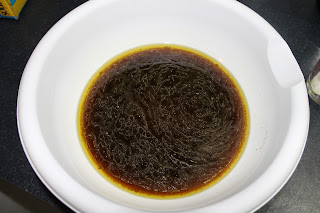I started pulling the thread. Now the proverbial sweater that formed my worldview concerning food and health is rapidly unraveling. I researched ethanol. I read articles about soy. I watched Food, Inc. I became someone who reads blogs. I became someone who writes a blog. I realized that if it's manufactured and marketed on a staggeringly massive scale, it's likely that big money is behind it, and big money is more concerned about big money than it is our health.
I eagerly anticipate the day that we can move onto some acreage with our own well water, raising our own chickens, and growing more of our own food. I daydream about someday possibly growing my own wheat to be milled into flour and then made into bread, sweetened with honey from our own bees - as much for the health and taste benefits as for the satisfaction of having produced it myself from start to finish. But I don't want to just dream. I don't want to "If only..." So I'm starting now. I want to start making all the changes I can right now, in this urban context, to reap as many benefits as I can as soon as I can, and to prepare for the transition to rural, sustainable living.
If you want to learn more about what may be in your supermarket bread, you can read this article: Why I Never Eat Commercial Bread.
If you are concerned and want to do something proactive about your health, you can try making your own bread. If you want to rediscover and preserve a lost art you can try making your own bread. If you just enjoy baking...try making your own bread.
As much as I enjoy cooking and baking, I had never made bread before. Bread intimidated me. Kneading, rising, temperatures, yeast...it had an air of mystery and peril about it. Then I tried it and it wasn't so bad. I did what I often do when I want to make something I've never made before. I went to food.com, searched whole grain bread, sorted by rating and chose the recipe with the best ratings. I was very pleased with the result! It was delicious and easy! If you want to check out the original recipe, it can be found here.
I don't knead this bread, and it has a longer rise time which is supposed to neutralize phytates which are a source of debate as to their healthfulness. Plus, it makes it super easy.
The first two times I made it, I used a fine flour and got light fluffy loaves. The third time, I used a coarser, stone ground flour and it yielded heavier, heartier loaves. Next time I run out of flour, I want to try purchasing wheat berries and grinding my own flour.
What you'll need:
2 ¾ c hot water
1⁄3 c olive oil, any oil is fine
1⁄3 c honey
2 T molasses
1 T salt, sea salt is good
7 ½ c 100% whole grain wheat flour
2 T dry active yeast
Place the first five ingredients in the bowl and mix.
Add 2 c flour to cool the water and end up with warm dough
Add 2 T of dry active yeast
Add 4 c of flour. Mix until the consistency is somewhat even. If necessary, slowly add flour 1/2 c at a time until the dough quits sticking to the sides of the bowl. It should be tacky to the touch. The trick is to have enough consistency to stand up with the least amount of flour so the bread will be fluffy. It will most likely be 6 1/2 cups but in any case do not exceed 7 1/2 cups of wheat flour. Don't over mix or the bread will be tough.
When your dough is finished, cover the bowl and let it rise for about 30-45 minutes. The dough will be larger but it doesn't need to double.
Grease two bread pans with shortening.
Mix the dough again just enough to knock it down to close to the original size.
Drop the dough on a floured surface so you can work the dough and shape it. Shape it with your hands to make a nice ball, getting enough flour on it so it isn't sticky. Divide the ball in half and do it again. Shape the loaves by turning the dough under it's self over and over. When the dough is shaped the sides and ends will be sealed and all you will see is a nice oblong shaped loaf with smooth sides and top. Drop the loaves in your bread pans and let them rise until almost doubled.
Bake in a preheated oven at 350 for 35 minutes. Loaves should be slightly browned and sound hollow when tapped.
When done turn the bread out of the pan to a rack to cool.
Don't wrap it until completely cooled, as condensation will make it soggy.
Enjoy!!
-Kendra







No comments:
Post a Comment